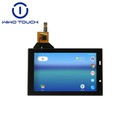When you touch your cell phone screen, the touch is sensed through capacitive measurements underneath the glass. Capacitance describes the ability of anything to hold a “charge”. When you shuffle your feet across a carpet then touch a metal object and experience a static shock, that’s your body experiencing capacitance. Your body was acting as a capacitor, and storing the static electric energy picked up from the carpet. When you touch your phone, the screen senses your finger because of the increased capacitance your body introduces around an electrical grid embedded in the display.

The anatomy of a touchscreen begins with a conductive grid made up of horizontal conductors and vertical conductors (as shown in the figure). The grid lines are etched on opposite sides of a thin plastic insulating sheet that is glued to the back of the glass lens. The grid is energized by a voltage creating an electrostatic field. These conductive lines cross and form tiny capacitors. The circuitry in your device senses this and measures it. So, for example, when your phone senses that the capacitance on horizontal line #50 and the vertical line #100 changed, it knows you touched at that intersection on the screen. Actually, when you touch the screen, you register a lot of contact points and your phone has to figure out what you want.




